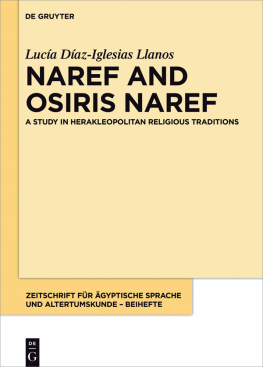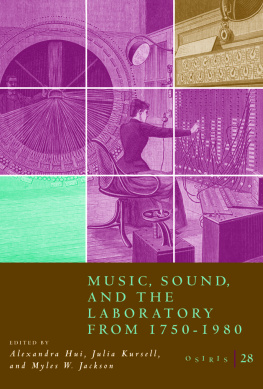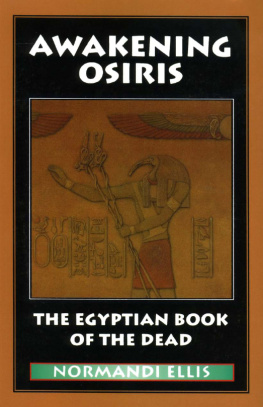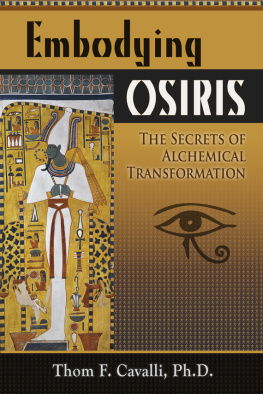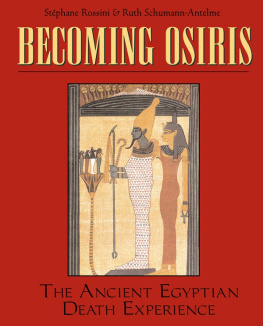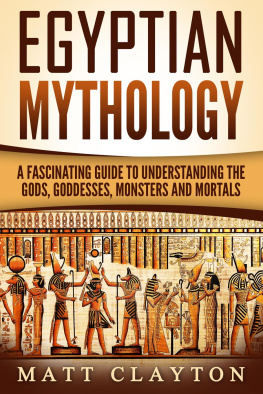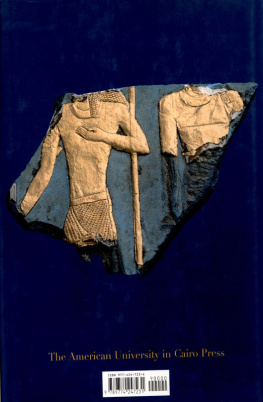Table of Contents
Guide

Luca Daz-Iglesias Llanos
Naref and Osiris Naref
Zeitschrift fr gyptische Sprache und Altertumskunde
Beihefte

Herausgegeben von
Susanne Bickel, Hans-Werner Fischer-Elfert,
Antonio Loprieno, Sebastian Richter
Beirat
John Baines, Elke Blumenthal, Julia Budka,
Richard Parkinson, Kim Ryholt,
Stephan Seidlmayer, Jean Winand
Band 3

ISBN 978-3-11-050104-9
e-ISBN (PDF) 978-3-11-049856-1
e-ISBN (EPUB) 978-3-11-049824-0
ISSN 2198-5790
Library of Congress Cataloging-in-Publication Data
A CIP catalog record for this book has been applied for at the Library of Congress.
Bibliographic information published by the Deutsche Nationalbibliothek
The Deutsche Nationalbibliothek lists this publication in the Deutsche Nationalbibliografie; detailed bibliographic data are available in the Internet at http://dnb.dnb.de.
2017 Walter de Gruyter GmbH, Berlin/Boston
www.degruyter.com
Foreword
This study on the toponym Naref and the god Osiris Naref derives from my doctoral dissertation on the mythological traditions of Herakleopolis Magna (capital of the 20 th Upper Egyptian province) and its surroundings, written under the direction of Miguel ngel Molinero Polo and defended in the University of La Laguna (Spain) in 2012. This previous work aimed to explore the local mythemes, i.e . core mythological notions reworked in connection with the main religious, historical, cultural, landscape features of this city and area. While analysing these mythemes, it became clear that local beliefs, particularly the role played by the tutelary deity of a province/region, were of crucial importance in the development of local Osirian forms (Osiris Naref in the case of the Herakleopolitan area). For space limits it was not possible to include a chapter on Osiris Naref in the publication of the dissertation. I originally intended to publish the sources and results of my research on this local Osirian manifestation in an article, but the information collected in the meantime and its interpretation reached an untamable size for a journal article. A postdoctoral scholarship of the Swiss Confederation for the academic year 20132014 and a project centred on the regional characterisation of the god Osiris undertaken under the supervision of Susanne Bickel at the Egyptological Seminar of the University of Basel allowed me to turn a preliminary study on this deity into this monograph. The process of revision and preparation for print was undertaken while enjoying two contracts, first at the University of Basel and then at the Spanish National Research Council (within the Djehuty project, directed by Jos Galn). Thanks are due to Miguel ngel Molinero Polo as well, with whom I discussed the germ of many ideas related to Osiris Naref in the course of the preparation of my doctoral dissertation. I am grateful to Miguel ngel, Susanne, and Jos for their continuous support in the process of developing and bringing this research to publication. Sadly, Covadonga Sevilla Cueva, under whom I took my first steps in Egyptology, will not see the publication of this book, but Id like to extend grateful thanks for her continuous encouragement.
I would like to express my sincere gratitude to all the colleagues that have contributed to this book in numerous ways: by providing me with bibliographical references or scans of irretrievable articles and images, by actively discussing some of the issues addressed here, by suggesting new venues of research, and for kindly sharing their yet unpublished work with me. Due thanks thus go to: Hartwig Altenmller, Burkhard Backes, Susanne Bickel, Ralph Birk, Francisco Bosch-Puche, Laurent Coulon, Andrs Diego, Silvia Einaudi, Henning Franzmeier, Jos Manuel Galn, Ann-Kathrin Gill, Monica Hanna, Mara de los ngeles Jimnez, Giuseppina Lenzo, Andrea Loprieno-Gnirs, David Klotz, Michela Luiselli, Daniel Mndez, Miguel ngel Molinero, Matthias Mller, Leire Olabarra, Jos Ramn Prez-Accino, Mara Carmen Prez Die, Mark Smith, Hannah Sonbol, Katharina Stvesand, Nria Torras Benezet, and Alba Villar. I am particularly indebted to Renate Germer and Sabine Schmidt for sharing with me their archival work on the material from Abusir el-Meleq kept at the gyptisches Museum und Papyrussammlung (Berlin) and for answering all my doubts with infinite patience. At a personal level, Manuel Rivas Fernndez has offered me his affection and constant support during this work, helping me to overcome the difficult moments that every research entails and engaging in the work of image processing. My family, specially my mother Eugenia Llanos, has always given me endless support during these years. This book is dedicated to Manuel and my mother for all the time that I could not spend with them.
Finally, Anna Garnett has undertaken with great diligence the task of proofreading this manuscript and has enhanced the English text making it easier to read, while Susanne Bickel has carefully and patiently gone through this research making useful suggestions and comments. Any shortcomings in the content or the interpretation of the sources used are, however, the sole responsibility of the author. I am further grateful to the editors of ZS-Beihefte for accepting this book in the series and to Mirko Vonderstein, Katrin Hofmann, and Florian Ruppenstein (De Gruyter) for their technical and editorial support and assistance during the formatting and publication process.
1Introduction
Naref was a conspicuous landmark of the Herakleopolitan territory (20 th Upper Egyptian nome, with capital in Herakleopolis Magna, modern Ihnasya el-Medina), frequently mentioned in funerary, cultic, and encyclopedical sources from the First Intermediate Period/Middle Kingdom until the Graeco-Roman Period. It rated amongst the most prestigious Osirian centres of the land, although it did not reach the overall importance of Abydos, Busiris, or Rosetau. A local form of Osiris, called Osiris Naref or Osiris in/of Naref, developed in connection with the traditions of this Upper Egyptian area and is attested from the New Kingdom onwards. Some articles and sparse references in monographs have been devoted to the analysis of different aspects of Naref. However, no comprehensive study has hitherto been undertaken to explain its meaning(s), function(s), and local attachment or to explore the different features encompassed in the figure of Osiris Naref.
This work has a two-fold objective. On the one hand, it aims to approach the funerary, legal, and royal mythological associations developed around the toponym Naref, which are attested for the first time in the so-called Coffin Texts (abbreviated CT from here onwards) and endure until the latest religious productions. On the other hand, it also seeks to analyse the characteristics of the local figure of Osiris Naref, a prominent deity in the Herakleopolitan pantheon from the New Kingdom onwards, who was informed by these mythical contexts and also achieved suprarregional importance. As will be argued in the different sections of , his key features centred on the mythical arguments of rebirth and defeat of enemies, justification, and assumption of royal power gave rise to an Osirian form who cannot/will not be evicted from the legitimate and secluded place he has reached. The diachronic analysis of the sources bearing references to Naref and to Osiris Naref also allows the detection of shifts of emphasis in religious concepts, thus contributing to the study of the different trends of theological speculation at both a central (or global) and regional levels.

